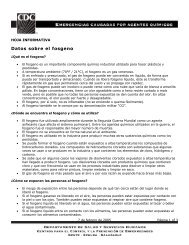Toxic Syndrome Description: Ricin or Abrin Poisoning
Toxic Syndrome Description: Ricin or Abrin Poisoning
Toxic Syndrome Description: Ricin or Abrin Poisoning
You also want an ePaper? Increase the reach of your titles
YUMPU automatically turns print PDFs into web optimized ePapers that Google loves.
TOXIC SYNDROME DESCRIPTION<br />
<strong>Ricin</strong> <strong>or</strong> <strong>Abrin</strong> <strong>Poisoning</strong><br />
Summary statement<br />
<strong>Ricin</strong> is a potent biological toxin that is derived from cast<strong>or</strong> beans. Its mechanism of action in the<br />
body is inhibition of protein synthesis. Clinical manifestations are dependent on the route of<br />
exposure. Ingestion of ricin typically leads to profuse vomiting and diarrhea followed by<br />
multisystem <strong>or</strong>gan failure and possibly death within 36 to 72 hours of exposure. Inhalation of<br />
ricin typically leads to respirat<strong>or</strong>y distress, fever, and cough followed by the development of<br />
pulmonary edema, hypotension, respirat<strong>or</strong>y failure, and possibly death within 36 to 72 hours.<br />
The amount and route of the exposure to ricin and the prem<strong>or</strong>bid condition of the person<br />
exposed will contribute to the time of onset and the severity of illness. F<strong>or</strong> example, the<br />
inhalation of ricin would be expected to lead to a quicker onset of poisoning and to cause a m<strong>or</strong>e<br />
rapid progression of poisoning compared with the ingestion of ricin, given the same exposure<br />
amount.<br />
Signs and symptoms of exposure<br />
The following is a m<strong>or</strong>e comprehensive list of signs and symptoms that may be encountered in a<br />
person exposed to ricin. The list does not convey pri<strong>or</strong>itization <strong>or</strong> indicate specificity. Also, partial<br />
presentations (an absence of some of the following signs/symptoms) do not necessarily imply<br />
less severe disease.<br />
Gastrointestinal<br />
• Abdominal pain<br />
• Vomiting<br />
• Diarrhea (nonbloody <strong>or</strong> bloody)<br />
• Abn<strong>or</strong>mal liver function tests<br />
• Multiple ulcerations and hem<strong>or</strong>rhages of gastric and small-intestinal mucosa on endoscopy<br />
Respirat<strong>or</strong>y<br />
• Cough<br />
• Chest tightness<br />
• Dyspnea<br />
• Hypoxemia<br />
• Noncardiogenic pulmonary edema<br />
Skin and mucous membranes<br />
• Redness and pain of eyes and skin<br />
March 28, 2005 Page 1 of 2
<strong>Toxic</strong> <strong>Syndrome</strong> <strong>Description</strong>: <strong>Ricin</strong> <strong>or</strong> <strong>Abrin</strong> <strong>Poisoning</strong><br />
(continued from previous page)<br />
General<br />
• Fever<br />
• Fatigue<br />
• Weakness<br />
• Muscle pain<br />
• Dehydration<br />
Other <strong>or</strong>gans<br />
• Seizures (uncommon)<br />
• Cardiovascular collapse (hypovolemic shock)<br />
Lab<strong>or</strong>at<strong>or</strong>y (nonspecific)<br />
• Metabolic acidosis<br />
• Increased liver function tests<br />
• Increased renal function tests<br />
• Hematuria<br />
• Leukocytosis (two- to five-fold higher than n<strong>or</strong>mal value)<br />
Note: The actual clinical manifestations of a ricin <strong>or</strong> abrin exposure may be m<strong>or</strong>e variable than<br />
the syndrome described above.<br />
Differential diagnosis<br />
Inhalation:<br />
• Staphylococcal enterotoxin B<br />
• Exposure to pyrolysis byproducts of <strong>or</strong>ganoflu<strong>or</strong>ines (Teflon, Kevlar)<br />
• Oxides of nitrogen<br />
• Phosgene<br />
• Ozone<br />
Ingestion:<br />
• Enteric pathogens<br />
• Mushrooms<br />
• Caustics<br />
• Iron<br />
• Arsenic<br />
• Colchicine<br />
This toxic syndrome description is based on CDC’s best current inf<strong>or</strong>mation.<br />
It may be updated as new inf<strong>or</strong>mation becomes available.<br />
F<strong>or</strong> m<strong>or</strong>e inf<strong>or</strong>mation, visit www.bt.cdc.gov/chemical, <strong>or</strong> call CDC at<br />
800-CDC-INFO (English and Spanish) <strong>or</strong> 888-232-6348 (TTY).<br />
March 28, 2005 Page 2 of 2
















